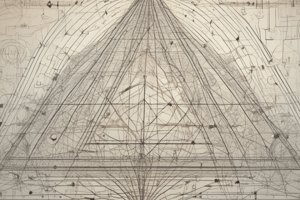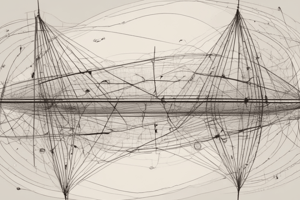Podcast
Questions and Answers
What is the primary characteristic that distinguishes a vector from a scalar?
What is the primary characteristic that distinguishes a vector from a scalar?
- Neither magnitude nor direction
- Both magnitude and direction (correct)
- Direction
- Magnitude
What type of vector represents the rate of change of an object's velocity?
What type of vector represents the rate of change of an object's velocity?
- Velocity vector
- Displacement vector
- Acceleration vector (correct)
- Momentum vector
What is the formula for calculating the work done on an object?
What is the formula for calculating the work done on an object?
- W = F × d × sin(θ)
- W = F × d
- W = F / d
- W = F × d × cos(θ) (correct)
What is the unit of power?
What is the unit of power?
What type of energy is associated with the motion of an object?
What type of energy is associated with the motion of an object?
What is the result when the force and displacement vectors are perpendicular?
What is the result when the force and displacement vectors are perpendicular?
What is the relationship between power and energy?
What is the relationship between power and energy?
What type of vector operation changes the magnitude of a vector but not its direction?
What type of vector operation changes the magnitude of a vector but not its direction?
What is the type of power that relates to the rate of doing mechanical work?
What is the type of power that relates to the rate of doing mechanical work?
What is the energy of an object due to its position or stored energy?
What is the energy of an object due to its position or stored energy?
Flashcards are hidden until you start studying
Study Notes
Vector
- A vector is a quantity with both magnitude (amount of movement) and direction.
- Vectors are often represented graphically using arrows in a coordinate system.
- Operations with vectors:
- Addition: combining two or more vectors by adding their corresponding components.
- Scalar multiplication: multiplying a vector by a number ( scalar) changes its magnitude but not its direction.
- Types of vectors:
- Displacement vector: represents the change in position of an object.
- Velocity vector: represents the rate of change of an object's position.
- Acceleration vector: represents the rate of change of an object's velocity.
Work
- Work is the transfer of energy from one object to another through a force applied over a distance.
- Formula: W = F × d × cos(θ), where:
- W is the work done (in joules, J)
- F is the force applied (in newtons, N)
- d is the distance over which the force is applied (in meters, m)
- θ is the angle between the force and the displacement vectors
- Units: joules (J) or newton-meters (N·m)
- Types of work:
- Positive work: force and displacement are in the same direction.
- Negative work: force and displacement are in opposite directions.
- Zero work: force and displacement are perpendicular.
Power
- Power is the rate at which work is done or energy is transferred.
- Formula: P = W / t, where:
- P is the power (in watts, W)
- W is the work done (in joules, J)
- t is the time over which the work is done (in seconds, s)
- Units: watts (W) or joules per second (J/s)
- Types of power:
- Mechanical power: relates to the rate of doing mechanical work.
- Electrical power: relates to the rate of electrical energy transfer.
Energy
- Energy is the ability to do work or cause change.
- Types of energy:
- Kinetic energy: the energy of motion.
- Potential energy: the energy of position or stored energy.
- Thermal energy: the energy of heat.
- Electrical energy: the energy associated with the movement of charged particles.
- Energy units:
- Joules (J)
- Kilowatt-hours (kWh) (1 kWh = 3.6 MJ)
- Energy conservation: the total energy of an isolated system remains constant, but can be converted from one form to another.
Vector
- A vector is a quantity with both magnitude and direction.
- Graphical representation: arrows in a coordinate system.
- Operations:
- Vector addition: combining vectors by adding corresponding components.
- Scalar multiplication: multiplying a vector by a number changes its magnitude, not direction.
- Types of vectors:
- Displacement vector: represents change in position of an object.
- Velocity vector: represents rate of change of an object's position.
- Acceleration vector: represents rate of change of an object's velocity.
Work
- Work is the transfer of energy through a force applied over a distance.
- Formula: W = F × d × cos(θ), where W is work done, F is force, d is distance, and θ is the angle between force and displacement vectors.
- Units: joules (J) or newton-meters (N·m).
- Types of work:
- Positive work: force and displacement are in the same direction.
- Negative work: force and displacement are in opposite directions.
- Zero work: force and displacement are perpendicular.
Power
- Power is the rate at which work is done or energy is transferred.
- Formula: P = W / t, where P is power, W is work done, and t is time.
- Units: watts (W) or joules per second (J/s).
- Types of power:
- Mechanical power: relates to rate of doing mechanical work.
- Electrical power: relates to rate of electrical energy transfer.
Energy
- Energy is the ability to do work or cause change.
- Types of energy:
- Kinetic energy: energy of motion.
- Potential energy: energy of position or stored energy.
- Thermal energy: energy of heat.
- Electrical energy: energy associated with movement of charged particles.
- Energy units:
- Joules (J)
- Kilowatt-hours (kWh) (1 kWh = 3.6 MJ)
- Energy conservation: total energy of an isolated system remains constant, but can be converted from one form to another.
Studying That Suits You
Use AI to generate personalized quizzes and flashcards to suit your learning preferences.




